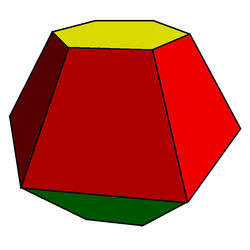Hexagonal bifrustum
The hexagonal bifrustum or truncated hexagonal bipyramid is the fourth in an infinite series of bifrustum polyhedra. It has 12 trapezoid and 2 hexagonal faces. This polyhedron can be constructed by taking a hexagonal dipyramid and truncating the polar axis vertices, making it into two end-to-end frustums.
| Hexagonal Bifrustum | |
|---|---|
 | |
| Type | Bifrustum |
| Faces | 12 trapezoids, 2 hexagons |
| Edges | 24 |
| Vertices | 18 |
| Symmetry group | D6h |
| Dual polyhedron | elongated hexagonal dipyramid |
| Properties | convex |
Several types of crystal take this shape.[1] It has also been used in the design of 14-sided dice, which may be used to generate randomly chosen playing cards.[2] It also has application in novelty promotional calendars: one month can appear on each of the trapezoids, and an advertising or other message on each of the hexagons.
References
- Romanowski, W. (December 1969), "Equilibrium forms of very small metallic crystals", Surface Science, 18 (2): 373–388, doi:10.1016/0039-6028(69)90180-0.
- Set of five, fourteen sided poker dice, Patent US 8074986 B1, Douglas A. Gebhart, filed September 30, 2008.
External links
- Conway Notation for Polyhedra Try: t6dP6
This article is issued from Wikipedia. The text is licensed under Creative Commons - Attribution - Sharealike. Additional terms may apply for the media files.